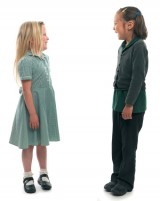Donna Minto shows you how to warble your way to a happy, healthy classroom...
I used to think colleagues knew I was coming because they recognised my footsteps clicking down the corridor. However, I’ve since discovered it’s my constant whistling and warbling that gives the game away.
As a music specialist, singing all the time is somewhat of an occupational hazard - but that’s not a bad thing. In actual fact I really enjoy it. After all, singing is good for you; it certainly has a positive effect on pupils’ well being.
Using singing games in the classroom will put a smile on children’s faces. It’s also a useful tool for keeping them focused; often a five minute diversion will leave pupils in the right frame of mind to continue their work with renewed enthusiasm.
To see for yourself, why not try the following three singing activities? They can be easily slotted into the school day and will contribute towards a cheerful, cooperative classroom.
If your class is restless and struggling to focus on the task in hand, why not try sliding into a short distraction by singing My Bonnie? Ask the children to stand up on the first ‘Bonnie’ then sit down on the second ‘Bonnie’? Continue until the song is finished (they should all end up sitting). Repeat the song, but this time children should stand up or sit down on any word beginning with “B” (they should still end up sitting but having moved many more times). You can develop this further by dividing your class into two groups. One group move only on “Bonnie” whilst the other group move on all words beginning with “B”.
My Bonnie lies over the ocean
My Bonnie lies over the sea
My Bonnie lies over the ocean
O bring back my Bonnie to me
Bring back, bring back,
O bring back my Bonnie to me, to me
Bring back, bring back,
O bring back my Bonnie to me
 Being involved in this singing game will benefit children and teachers in so many ways. It’s a useful diversion tactic that refocuses children’s attention, and a bit of fun. It also helps develop rhythm, physical co-ordination, critical thinking, memory recall, listening and logic.
Being involved in this singing game will benefit children and teachers in so many ways. It’s a useful diversion tactic that refocuses children’s attention, and a bit of fun. It also helps develop rhythm, physical co-ordination, critical thinking, memory recall, listening and logic.
Those pupils who find it hard to concentrate will be swept along with their peers in endeavouring to ensure they stand and sit at the right time. Their minds will be sharpened, focused and ready for the next task – at least for another ten minutes…
If you feel your classroom is getting too noisy and that this is becoming a distraction, you could try ‘Singing ‘Structions’. Using no more than three notes – I suggest G, E and A – sing out instructions to the class and ask them to echo your orders (also singing) when they hear them, e.g.
| Teacher | Class |
|---|---|
| Put away your paper | Putting away our paper |
| Line up at the door | Lining up at the door |
| Do it very quietly | Doing it very quietly |
| Listen as you go | Listening as we go |
To develop this idea you could ask a child to be the singing leader for the day or morning/afternoon. As teacher, you could even do all your one-to-one questioning in this manner.
Researchers at the Sidney de Haan Research Centre for Arts and Health (SDHRC) in Folkstone state:
“Music has a profound capacity to connect with and express our emotions, and can open up a world of experience and beauty, which goes beyond the mundane and banal realities of everyday life. It can provide a powerful resource in promoting health in a holistic sense, embracing physical, social and mental well-being.”
The following singing game gives ample opportunity for children to let go with their emotions.
Start by choosing some really well known songs, e.g.
• Happy Birthday
• Head, Shoulders, Knees and Toes
• If You’re Happy and You Know It
• The Wheels on the Bus
Pick one song and sing it in a chosen emotion e.g. sadly, angrily, in a posh voice, etc. Do this a few times, experimenting with different emotions, and ask the children to really go for it with facial expressions and body language.
To extend this idea, ask the children to keep their voice happy but display a different emotion in their expression, e.g. a happy voice with a sad face. This is really difficult to do and will take quite a bit of practice.
 Five reasons why singing is good for your health…
Five reasons why singing is good for your health…
1. Singing is an emotional release for adults and children alike so it destresses and relaxes you.
2. Singing promotes wellbeing. After singing you could experience any or all of the following: improved lung capacity, high energy, relieved asthma, better posture, enhanced feelings of relaxation, mood and confidence.
3. Singing improves your ability to listen – before singing a note, you have to first accurately hear it. This inner hearing is an aid to all silent problem solving, such as maths and science, and also a crucial skill for silent reading. There is very little you can achieve without listening.
4. Singing improves your breathing, and breath is life! With so much time spent sitting in front of a computer, we are in danger of becoming a race of shallow breathers.
5. Singing boosts the immune system. A study at the University of Frankfurt found that choir members had higher levels of immunoglobulin A and cortisol – markers of enhanced immunity – after they sang Mozart’s Requiem than before. Just listening to the music did not have this effect.
“The greatest service to the population would be if every school day could begin with singing. I have never met a member of a choir who was depressed” Yehudi Menuhin
Make sure children don’t feel judged…
When teaching children to sing individually, it’s extremely important to cultivate an atmosphere which is encouraging and non-judgemental. A child can be inhibited for life by a critical look or negative reaction to his contribution.
When a child shares his singing voice with others in a group, he is vulnerable as he is opening himself up to a considerable degree. It is vital that clear ground rules are established, the most important being that everyone’s contribution is valued and appreciated.
Equally, if a child chooses not to sing, treat that choice with respect – silence is a vital part of any music making. It is so important that singing games are not threatening in any way, but relaxed and fun. A child will still be able to participate with the whole group even when they don’t feel confident enough to sing alone.
The singing games outlined in this article have been taken from Donna Minto’s recent book Games, ideas and activities for Primary Music, published by Pearson. For a 20% discount on this and other titles in the Classroom Gems series, visit http://www.pearsonbooks. com/teachprimary
Donna Minto has been involved in music teaching for 30 years. Her current post involves teaching in four primary schools. She has written 25 topic related songbooks under the banner of Notable Songs Ltd (notablesongs.co.uk) and has obtained the status of Chartered Teacher, awarded by the General Teaching Council of Scotland.
Should you let educational researchers into your classroom?
Ace-Classroom-Support
Use scaffolding to wean children off high levels of TA support
Ace-Kitchen-Manager
